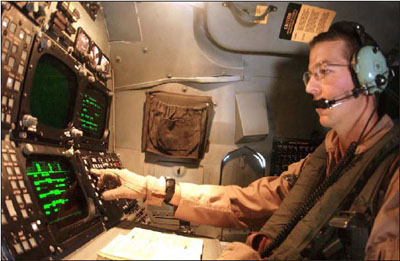Airc rews flying the B-1B bomber, known as the Bone, in Southwest Asia say it is the “backbone of America’s long-range bomber force.” Air Force journalist Maj. Ann Knabe reports on one Bone mission over Afghanistan, quoting Lt. Col. David Been, 37th Expeditionary Bomb Squadron commander, who said the B-1 is “wicked fast,” making it possible to “respond anywhere in Afghanistan within minutes.” That time is crucial when the bomber crew must answer a “troops in contact” request, which means friendlies are under attack and “there’s no time to spare,” said Been. The B-1 can put precision munitions on target or simply rout an enemy force by its presence. Capt. Craig Morrison, weapons systems officer, describes the B-1 as “great for showing power, [because] we fly low, we fly fast and let the enemy know we are there.”
rews flying the B-1B bomber, known as the Bone, in Southwest Asia say it is the “backbone of America’s long-range bomber force.” Air Force journalist Maj. Ann Knabe reports on one Bone mission over Afghanistan, quoting Lt. Col. David Been, 37th Expeditionary Bomb Squadron commander, who said the B-1 is “wicked fast,” making it possible to “respond anywhere in Afghanistan within minutes.” That time is crucial when the bomber crew must answer a “troops in contact” request, which means friendlies are under attack and “there’s no time to spare,” said Been. The B-1 can put precision munitions on target or simply rout an enemy force by its presence. Capt. Craig Morrison, weapons systems officer, describes the B-1 as “great for showing power, [because] we fly low, we fly fast and let the enemy know we are there.”
New B-52 Radar Makes First Flight
Dec. 12, 2025
The Air Force’s radar modernization effort for the B-52 Stratofortress entered flight testing recently, a “milestone” for the once over-budget system that senior leaders call the start of a new era for the Cold War bomber.

